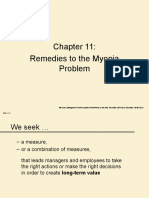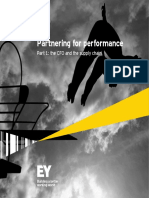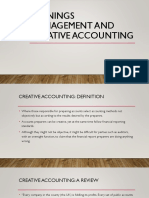Chapter 9
Chapter 9
Uploaded by
Ibrahim GencCopyright:
Available Formats
Chapter 9
Chapter 9
Uploaded by
Ibrahim GencOriginal Description:
Copyright
Available Formats
Share this document
Did you find this document useful?
Is this content inappropriate?
Copyright:
Available Formats
Chapter 9
Chapter 9
Uploaded by
Ibrahim GencCopyright:
Available Formats
Slide 9.
Chapter 9: Incentive Systems
Merchant, Management Control Systems PowerPoints on the Web, 3rd edition, Pearson Education Limited 2012
Slide 9.2
Financial results controls
Three core elements:
Financial responsibility centers
The apportioning of accountability for financial results within the organization
Formal management processes
Planning and budgeting to define performance expectations and standards for evaluating performance
Motivational contracts
To define the links between results and various organizational incentives
Merchant, Management Control Systems PowerPoints on the Web, 3rd edition, Pearson Education Limited 2012
Slide 9.3
Positive and negative incentives
Positive incentives
Things employees value
rewards punishments
Negative incentives
Things employees like to avoid
Individuals are believed to be more strongly motivated by the potential of earning rewards than by the fear of punishment
Merchant, Management Control Systems PowerPoints on the Web, 3rd edition, Pearson Education Limited 2012
Slide 9.4
Forms of rewards and punishments
Rewards
Monetary
Salary increases Bonuses Benefits Perquisites Club memberships Vacation trips
Promotion Autonomy Recognition Participation in decisions Office assignments Preferred parking places Titles
Punishments
Monetary
No raise No bonus No perquisites
Non-monetary
Non-monetary
Interference in job from superiors Loss of job Assignment to unimportant tasks No promotion Humiliation
Merchant, Management Control Systems PowerPoints on the Web, 3rd edition, Pearson Education Limited 2012
Slide 9.5
The compensation package
Salary Benefits
Pension and health benefits Perquisites of various types
Incentive compensation
Short-term incentive plans
Based on the performance in the current year or less
Long-term incentive plans
Based on the performance measured over periods greater than 1 year and often related to the companys stock price
Merchant, Management Control Systems PowerPoints on the Web, 3rd edition, Pearson Education Limited 2012
Slide 9.6
Short-term incentive plans
Based on performance in the current year or less For example, piece-rate payments, commissions, bonuses
Calculation (by formula) of short-term incentives
For example, 2% of sales; 10% of net profits For example, 60% of target bonus at 80% of target; 100% of target bonus at 100% of target (where target bonus = 30% of salary)
Merchant, Management Control Systems PowerPoints on the Web, 3rd edition, Pearson Education Limited 2012
Slide 9.7
Long-term incentive plans
Based on the performance measured over periods greater than 1 year
Usually restricted to higher management levels
Accounting performance (e.g., EPS, ROE, ROA)
over a period of 35 years
Market-based performance
Stock
options
Restricted
Stock
stock
appreciation rights
Merchant, Management Control Systems PowerPoints on the Web, 3rd edition, Pearson Education Limited 2012
Slide 9.8
Purpose of incentives
Motivation
Motivation has two elements Inducing effort: getting employees to work hard
Employees typically put forth more (less) effort on activities that are (not) rewarded
Directing effort: helping employees understand what is expected of them
Rewards attract the employees attention and inform them of the relative importance of often-competing results areas
Merchant, Management Control Systems PowerPoints on the Web, 3rd edition, Pearson Education Limited 2012
Slide 9.9
Purpose of incentives (continued)
Attraction/retention
Paying employees only guaranteed salaries tends to attract risk-averse employees
Paying performance-dependent compensation tends to attract employees who are more risk tolerant, more aggressive, more confident in their abilities
Restricted stock, for example, often are geared towards employee retention
golden handcuffs
Merchant, Management Control Systems PowerPoints on the Web, 3rd edition, Pearson Education Limited 2012
Slide 9.10
Purpose of incentives (continued)
Non-control
purposes
Provide a competitive compensation package Make compensation variable with firm performance Tax considerations
Merchant, Management Control Systems PowerPoints on the Web, 3rd edition, Pearson Education Limited 2012
Slide 9.11
Key incentive design elements
Size of awards (fixed vs. variable pay) Level and type of measurement
Performance at the individual, entity or company level
Financial vs. non-financial performance; single or multiple measures or performance criteria
Shape of the performance-reward function Use of subjectivity
Merchant, Management Control Systems PowerPoints on the Web, 3rd edition, Pearson Education Limited 2012
Slide 9.12
Proportion variable pay
Employees are risk averse ...
Performance-dependent rewards impose risk on the employees as performance is never fully controllable Across firms, differences in the proportion of atrisk pay are greater than differences in base pay Levels of at-risk pay generally decrease at lower organization levels
Merchant, Management Control Systems PowerPoints on the Web, 3rd edition, Pearson Education Limited 2012
Slide 9.13
Shape of reward function
Commonly, the link between rewards and results is linear, but over a restricted performance range only
MAX
Rewards ($)
ZERO
Results (profit)
LOW
80% of budget target
100% of budget target
150% of budget target
HIGH
Merchant, Management Control Systems PowerPoints on the Web, 3rd edition, Pearson Education Limited 2012
Slide 9.14
Cutoffs
Lower cutoff
To avoid paying bonuses for performance which is considered mediocre or worse
Upper cutoff
To maintain vertical compensation equity
To keep total compensation somewhat smooth over time To avoid the fact that managers will be unduly motivated to take actions to maximize bonus payouts To avoid undeserved bonuses due to windfall gains To alleviate the possibility of a faulty compensation plan design
Merchant, Management Control Systems PowerPoints on the Web, 3rd edition, Pearson Education Limited 2012
Slide 9.15
Group rewards
Team-based rewards are often used to implement personnel / cultural controls
Group members monitor and sanction each others behaviors
They rarely provide a direct incentive effect
Stock-based plans, for instance, provide direct incentives only for a small number of managers at the very top of the firm Hence, for lower-level employees, compensation is made more volatile, although motivation may not be (greatly) affected
Merchant, Management Control Systems PowerPoints on the Web, 3rd edition, Pearson Education Limited 2012
Slide 9.16
Bonus determination approach
Formulaically
The performance-reward link is explicit Alleviates bias or favoritism in assessing and rewarding performance but Possibly less focus on performance dimensions that are more difficult to quantify (e.g., R&D)
Subjectively
Allows performance to be evaluated more completely considering any of a number of hard-to-quantify, but important, performance areas Lack of explicitness increases the employee's risk (due to possible bias)
Merchant, Management Control Systems PowerPoints on the Web, 3rd edition, Pearson Education Limited 2012
Slide 9.17
Criteria for evaluating reward systems
Rewards should be valued
Rewards that have no value do not provide motivation Reward tastes vary across individuals and are situational
Rewards should be large enough to have impact
Reward visibility can affect impact
Rewards should be understandable
What is the reason for earning the reward?
Rewards should be timely
The discount rate employees apply to delayed rewards is said to be greater than the time value of money
Merchant, Management Control Systems PowerPoints on the Web, 3rd edition, Pearson Education Limited 2012
Slide 9.18
Criteria for evaluating reward systems (continued)
Rewards should be durable
Rewards have greater value if positive feelings generated through the reward are long-lasting, that is, if employees remember them
Rewards should be reversible
To make rewards variable with performance and to create a lasting incentive effect (pay-for-performance vs. pay-for-pulse) Promotions, for instance, are difficult to reverse
Rewards should be cost efficient
To stimulate the desired motivation at minimal cost
Merchant, Management Control Systems PowerPoints on the Web, 3rd edition, Pearson Education Limited 2012
You might also like
- Work Permit Renewal Application FormDocument2 pagesWork Permit Renewal Application FormyamojodnabNo ratings yet
- CS011A Career Investigation Project InteractiveDocument11 pagesCS011A Career Investigation Project Interactivejazz440No ratings yet
- The Powerx Strategy: Companion GuideDocument34 pagesThe Powerx Strategy: Companion GuideRePro100% (1)
- History of Performance ManagementDocument26 pagesHistory of Performance ManagementRahul R G Kurup100% (1)
- Chapter 14Document19 pagesChapter 14Yuxuan Song100% (1)
- Chapter 08Document17 pagesChapter 08Yuxuan SongNo ratings yet
- Chapter 11Document22 pagesChapter 11Yuxuan SongNo ratings yet
- Chapter 12Document15 pagesChapter 12Yuxuan SongNo ratings yet
- Chapter 10Document19 pagesChapter 10Yuxuan SongNo ratings yet
- Chapter 13Document16 pagesChapter 13Yuxuan SongNo ratings yet
- Action, Personnel, and Cultural ControlsDocument15 pagesAction, Personnel, and Cultural Controlsevaluv100% (1)
- Overview of The Integrity Management ProgramDocument16 pagesOverview of The Integrity Management ProgramNELSON NISPEROSNo ratings yet
- Chapter 17Document9 pagesChapter 17Yuxuan Song100% (1)
- 1 Why Business Unit Controllers Create Budget Slack - Involvement in Management - Social Pressure - and Machiavellianism - 1Document24 pages1 Why Business Unit Controllers Create Budget Slack - Involvement in Management - Social Pressure - and Machiavellianism - 1Rizky EriandaniNo ratings yet
- Netflix 2Document8 pagesNetflix 2Brittany Price100% (2)
- Chapter 3 Action, Personnel, and Cultural ControlsDocument15 pagesChapter 3 Action, Personnel, and Cultural ControlsAdrian ChrisceydiNo ratings yet
- Fore - Case # 7 What They Didnt Teach in Sales Class at My Business School Nov 2010Document3 pagesFore - Case # 7 What They Didnt Teach in Sales Class at My Business School Nov 2010Ankit AggarwalNo ratings yet
- Options and Corporate Finance QuestionsDocument2 pagesOptions and Corporate Finance QuestionsbigpoelNo ratings yet
- Project On Futures and OptionsDocument19 pagesProject On Futures and Optionsaanu1234No ratings yet
- Marketing Plan HPDocument17 pagesMarketing Plan HPJuan XiaNo ratings yet
- Lease Financing: Presentation By: Mohammed Akbar KhanDocument30 pagesLease Financing: Presentation By: Mohammed Akbar KhanMohammed Akbar KhanNo ratings yet
- Slides CH01Document21 pagesSlides CH01Daniel ChristandyNo ratings yet
- EY Partnering For Performance The CFO and The Supply Chain PDFDocument44 pagesEY Partnering For Performance The CFO and The Supply Chain PDFLuong Thu HaNo ratings yet
- Law On Contracts ReviewerDocument35 pagesLaw On Contracts ReviewerR VNo ratings yet
- Job Description - Financial Controller: OverviewDocument6 pagesJob Description - Financial Controller: OverviewAmrita SinghNo ratings yet
- Accounting Information System 2Document34 pagesAccounting Information System 2kabamignon100% (1)
- How Do You Value A Company?Document3 pagesHow Do You Value A Company?Sumit DaniNo ratings yet
- CH 23Document25 pagesCH 23YolomanNo ratings yet
- IAS 16 - Property, Plant & EquipmentDocument34 pagesIAS 16 - Property, Plant & EquipmentBill YuNo ratings yet
- Meaning and Nature of Accounting PrincipleDocument25 pagesMeaning and Nature of Accounting PrincipleVibhat Chabra 225013No ratings yet
- Bankruptcy Prediction ModelDocument13 pagesBankruptcy Prediction ModelShubham GuptaNo ratings yet
- Ratio AnalysisDocument33 pagesRatio AnalysisJhagantini PalaniveluNo ratings yet
- Financial RatiosDocument21 pagesFinancial RatiosAamir Hussian100% (1)
- Malbarosa v. CADocument18 pagesMalbarosa v. CAslashNo ratings yet
- Introduction To AuditingDocument18 pagesIntroduction To AuditingVipul Mehta100% (1)
- Earnings Management and Creative AccountingDocument13 pagesEarnings Management and Creative Accountingjaclyn3kohNo ratings yet
- Erp, CH01 - TBDocument8 pagesErp, CH01 - TBZainab EmranNo ratings yet
- The Theories Behind Corporate GovernanceDocument6 pagesThe Theories Behind Corporate GovernanceAnita KhanNo ratings yet
- Chapter 7 The Nature of Industry Generally PDFDocument21 pagesChapter 7 The Nature of Industry Generally PDFNeni BangunNo ratings yet
- Internal ControlsDocument5 pagesInternal ControlsRehab SabahNo ratings yet
- Classification of LiabilitiesDocument49 pagesClassification of LiabilitiesAmiraNo ratings yet
- MCS Case StudyDocument17 pagesMCS Case StudyPratik Tambe0% (1)
- Core CompetencyDocument3 pagesCore CompetencyAli M. AtallahNo ratings yet
- Investment Policy StatementDocument2 pagesInvestment Policy StatementHaseeb AhmadNo ratings yet
- Chapter 6 - Capital Budgeting PDFDocument34 pagesChapter 6 - Capital Budgeting PDFSyamala 29No ratings yet
- Tangible Non Current Assets NotesDocument39 pagesTangible Non Current Assets NotesmacphobiaprivatelimitedNo ratings yet
- AIS AssignmentDocument18 pagesAIS AssignmentImran Azad100% (1)
- Guidelines: Determining and Using Materiality Thresholds in Financial AuditDocument20 pagesGuidelines: Determining and Using Materiality Thresholds in Financial AuditMarisa Mae AngsiocoNo ratings yet
- Financial Statements Analysis - Q&aDocument6 pagesFinancial Statements Analysis - Q&aNaga NagendraNo ratings yet
- Stock Valuation MethodsDocument5 pagesStock Valuation MethodsgoodthoughtsNo ratings yet
- Who Created The Model?: The Eight Variables AreDocument4 pagesWho Created The Model?: The Eight Variables AreArbaz BabarNo ratings yet
- Inherent Risk LakesideDocument2 pagesInherent Risk LakesideSunny Mae100% (1)
- Derivatives. ... Syet Derivatives..Document42 pagesDerivatives. ... Syet Derivatives..Francis Emmanuel TolentinoNo ratings yet
- Chapter 2: The Demand For Money: Learning ObjectivesDocument12 pagesChapter 2: The Demand For Money: Learning Objectiveskaps2385No ratings yet
- CDA MC 2015-06 Philippine Financial Reporting Framework CooperativesDocument87 pagesCDA MC 2015-06 Philippine Financial Reporting Framework CooperativesJon DonNo ratings yet
- Management Accounting - Lecture 1Document15 pagesManagement Accounting - Lecture 1Farzana AkhterNo ratings yet
- Business Process OutsourcingDocument3 pagesBusiness Process Outsourcingmanhojkumar GNo ratings yet
- Internal Environment Analysis: Strategic ManagementDocument40 pagesInternal Environment Analysis: Strategic ManagementNavi RoshanNo ratings yet
- Ecopak Case Notes Chapter 4 5Document3 pagesEcopak Case Notes Chapter 4 5Gajan SelvaNo ratings yet
- The Balanced ScorecardDocument6 pagesThe Balanced ScorecardAhmad ZydanNo ratings yet
- Financial Management: Short-Term Financial PlanningDocument23 pagesFinancial Management: Short-Term Financial PlanningRao786No ratings yet
- Strategy Formulation - Internal AuditDocument31 pagesStrategy Formulation - Internal AuditChristiane100% (1)
- Slides CH10Document15 pagesSlides CH10Daniel ChristandyNo ratings yet
- 1 Kidzq AKE7 BR 3 MJ Ag Eh JQJDocument27 pages1 Kidzq AKE7 BR 3 MJ Ag Eh JQJhimanshu3kmNo ratings yet
- Speaking Part 1-2 - Jobs HomeworkDocument3 pagesSpeaking Part 1-2 - Jobs HomeworkThuy TranNo ratings yet
- DMBA401 Unit-06Document26 pagesDMBA401 Unit-06Shivam TiwariNo ratings yet
- Property Management System Literature ReviewDocument5 pagesProperty Management System Literature Reviewc5qwqy8v100% (1)
- Villanueva - 202065068 - Research and Statistics - Assignment 1Document3 pagesVillanueva - 202065068 - Research and Statistics - Assignment 1Aaron Dale VillanuevaNo ratings yet
- 12 CH 6 Principles of MGTDocument43 pages12 CH 6 Principles of MGTArkin DixitNo ratings yet
- The Business Environment 1Document63 pagesThe Business Environment 1Cassandra Guenevere 023 LEENo ratings yet
- Singapore Employment Act PDFDocument85 pagesSingapore Employment Act PDFSiputs SedutNo ratings yet
- Chapter 1 - Organizational BehaviorDocument27 pagesChapter 1 - Organizational BehaviorchxrlttxNo ratings yet
- Final report - Sales Management - Nguyễn Thị Mỹ Huyền - 215221599 - Ca 2Document23 pagesFinal report - Sales Management - Nguyễn Thị Mỹ Huyền - 215221599 - Ca 2Vũ Nguyễn Huỳnh DuyNo ratings yet
- Methodology MDG Scan 3 V 4Document14 pagesMethodology MDG Scan 3 V 4Andrew GroganNo ratings yet
- CSR Annual Report Fy 2020 21Document68 pagesCSR Annual Report Fy 2020 21SeshangNo ratings yet
- HRM 2019Document94 pagesHRM 2019ChandraNo ratings yet
- Tabuk (TAMPCO) Vs DuclanDocument3 pagesTabuk (TAMPCO) Vs Duclanopep77100% (1)
- Bachelor ThesisDocument15 pagesBachelor Thesismarcu97No ratings yet
- Bài Thi TA, 6,7,8,9,10Document51 pagesBài Thi TA, 6,7,8,9,10Đinh Xendo OfficialNo ratings yet
- Maternal Leave Policies - An International Survey by Harvard Women's Law JournalDocument27 pagesMaternal Leave Policies - An International Survey by Harvard Women's Law JournalAishvarya PujarNo ratings yet
- 110 SMC V NLRC 1999 (Jose)Document2 pages110 SMC V NLRC 1999 (Jose)TheodoreJosephJumamilNo ratings yet
- Juco vs. NLRCDocument4 pagesJuco vs. NLRCRomy Ian LimNo ratings yet
- BSBMGT517 Management Operational 4747 PDFDocument79 pagesBSBMGT517 Management Operational 4747 PDFNicolas EscobarNo ratings yet
- MGT Grand Quiz File PDFDocument42 pagesMGT Grand Quiz File PDFAqsa100% (1)
- Budget Call 2013Document85 pagesBudget Call 2013egabad0% (1)
- PTDC Service Rules Staff 2009Document38 pagesPTDC Service Rules Staff 2009Yaseen AyazNo ratings yet
- Hong Kong Monthly Digest of Statistics 202402Document309 pagesHong Kong Monthly Digest of Statistics 202402chanchunho123456No ratings yet
- Business Process Performance MeasurementDocument31 pagesBusiness Process Performance MeasurementShivkarVishalNo ratings yet
- HR ContentsDocument10 pagesHR Contentsआशिष प्रकाश बागुलNo ratings yet
- Tamirat Motel FinalDocument34 pagesTamirat Motel FinalMelese FirdisaNo ratings yet

























































































